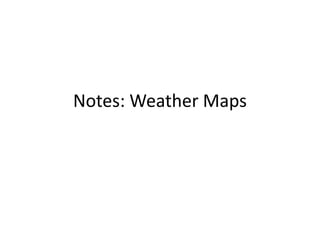
11-weather maps notes.pptx
- 2. How do you read weather symbols?
- 3. What is the percent cloud cover at the station? What is the wind speed in knots? What direction is the wind coming FROM? What direction is it going to? This funny looking thing is a weather symbol. It represents data recorded from a weather station. The circle is cloud cover. The “tail” is the wind direction. The feathers are the wind speed in knots. (1 knot = 1.15 miles) 0% 15 knots NW SE
- 4. • 1) Draw a weather symbol with – ½ cloud cover – wind at 5 knots out of the northeast.
- 5. • 2) Draw a weather symbol with – 60% cloud cover – wind out of the west at 55 knots.
- 6. What is a weather system? • Remember the rule of thumb. • Wind flows from areas of high to low pressure!
- 7. • Air pressure is equal to the weight of a column of air at a particular location. It is measured in millibars (mb) • High pressure systems are regions of relatively high pressure. – They are associated with dry weather and clear skies. Why? - Air flows from high to low pressure. Air sinks and flows away from a high pressure system. Therefore, few or no clouds form.
- 8. • Low pressure systems are areas of relatively low pressure. They are associated with clouds and precipitation. Why? Air flows from high to low pressure. Air flows toward a low pressure system and rises. Therefore, many clouds form.
- 9. What are fronts? • An air mass is a large body of air with similar temperature, pressure, and humidity throughout. • A “front” is a boundary between air masses. • We talk about “warm fronts” and “cold fronts.” These both happen with low pressure systems. Why can’t they occur in high pressure systems? Air flows from high to low pressure. Air sinks and flows away from a high pressure system. Therefore, few or no clouds form.
- 10. Cold Fronts – A cold front is a boundary between an advancing cold air mass and a warm air mass that is already present. – It is represented by triangles that point the direction the front is moving. – Precipitation/clouds occur behind the front. – Why?
- 11. • Cold air is more dense and “pushes” the less dense warm air up. Clouds form and precipitation occurs behind the cold front. (I.e. it gets cold before it rains).
- 12. Do cold fronts have to be “cold?” As in freezing?
- 13. Warm Fronts A warm front is a boundary between an advancing warm air mass and a cold air mass that is already present. It is represented by semi-circles that point the direction the front is moving. Precipitation/clouds occur ahead of the front. Why?
- 14. • Warm air is less dense and rises above the cold air. It condenses and forms clouds ahead of the front.
- 15. Brings cold air Clouds and precipitation behind the front Clouds and precipitation ahead of the front Brings warm air Brings a weather change. Occurs during a low pressure system. Cold Front Warm Front